- Boldface Absolute Correlations > 0.5
- Set Decimal Places for Output Tables
- Transpose One or Many Output Tables
- Delete Selection of Output Items
- Set Font Sizes and Styling for Output Tables
- Set Exact Sizes for Charts
All examples require SPSS version 22 or higher. We'll use bank_clean.sav (screenshot below) throughout this entire tutorial.
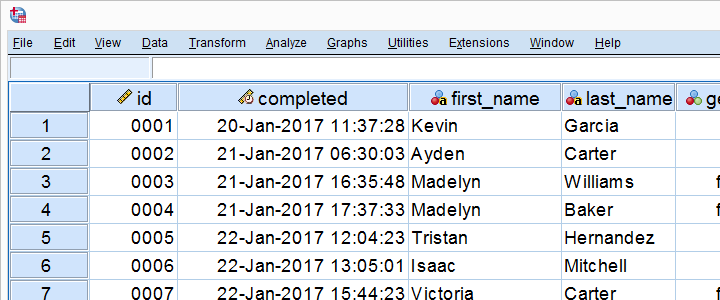
OUTPUT MODIFY - What and Why?
OUTPUT MODIFY is an SPSS command that edits one or many SPSS output items -mostly tables and charts- by syntax.
OUTPUT MODIFY was introduced in SPSS version 22 and -together with Python- is among the most important time savers in SPSS.
OUPUT MODIFY is available from the menu -we'll get to that in a minute- but we recommend copy-paste-editing or just typing the syntax.
Alternatives for OUTPUT MODIFY
Prior to OUTPUT MODIFY there were 3 options for editing output items after creating them:
- manually: most properties of output items can be edited after double-clicking them.For some adjustments, this is still the only reasonable way to go. This is better avoided since it is very time consuming and not replicable.
- SPSS scripting: unknown to many users, SPSS includes a scripting language known as SaxBasic which is related to VBA. SPSS scripting has been deprecated in favor of Python introduced in SPSS version 14.
- Python scripting: the most powerful option to edit basically anything in the output viewer may require a steep learning curve. If OUTPUT MODIFY doesn't get it done, Python-scripting probably will.
Instead of using OUTPUT MODIFY, you may also edit output items before creating them:
- Variable formats -set with FORMATS or ALTER TYPE- mostly dictate how statistics show up in output tables.
- You can apply styling to charts by setting a chart template before creating them. Applying chart templates after creating charts -manually, with Python scripting or with OUTPUT MODIFY- is usually less convenient.
- For creating prettier tables, set a tablelook before creating your tables. Again, you can apply table templates after creating tables but that's often less handy.
- OMS can prevent the creation of output items altogether. An example is the often undesired “Case processing summary” table that comes with CROSSTABS.
OUTPUT MODIFY from SPSS’ Menu
Let's first run a quick correlation matrix from the syntax below. Again, we'll use bank_clean.sav throughout this entire tutorial.
factor
/variables q1 to q9
/print correlation.
Let's now try and boldface all absolute correlations > 0.50 by running OUTPUT MODIFY from the menu. Our first option is navigating to
 but this is only present when you're in the output viewer window.
but this is only present when you're in the output viewer window.
Our second option is to select after right-clicking an output item. In either case, we'll first get the output selection dialog shown below.
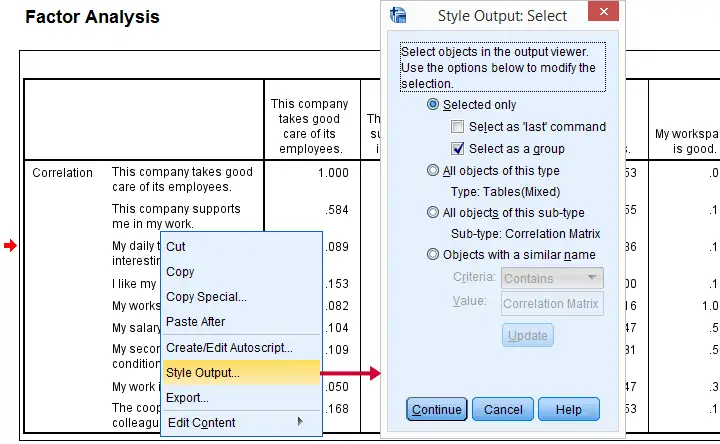
You can now make a selection of output items you'd like to modify. Personally, I think there's too many options here and it's unclear to me what they mean. I find it much easier to make my selection in the syntax. Clicking opens the main dialog.
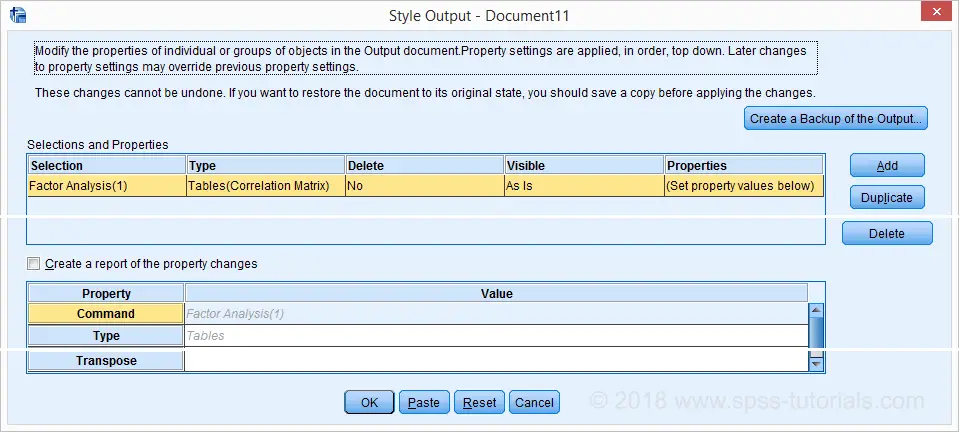
The main OUTPUT MODIFY dialog allows you to specify modifications for elements of your output items. I'll skip the details because -again- I find this easier to do this from syntax. In any case, the best syntax I could paste from the menu is shown below.
OUTPUT MODIFY Example - Pasted from Menu
OUTPUT MODIFY NAME=Document7
/REPORT PRINTREPORT=NO
/SELECT TABLES
/IF COMMANDS=["Factor Analysis(1)"] LABELS=[EXACT("Correlation Matrix")] INSTANCES=[1]
/DELETEOBJECT DELETE=NO
/OBJECTPROPERTIES VISIBLE=ASIS
/TABLECELLS SELECT=[CORRELATION] SELECTDIMENSION=COLUMNS SELECTCONDITION="Abs(x)>=0.5"
STYLE=REGULAR BOLD APPLYTO=CELL.
OUTPUT MODIFY - Syntax Problems
The syntax we just pasted is utter stupidity because it won't work in most situations; NAME=Document7 restricts the command to an output window named “Document7”. That's where my table resides now but probably not tomorrow when I continue working on my project. Let alone when a colleague or client tries to replicate my work. This defeats the whole point of working from syntax in the first place.
Furthermore, the syntax is way too long and complex to write manually but most of it does absolutely nothing. Now, most things in SPSS -including OUTPUT MODIFY- are best done by writing simple, clean syntax. Sadly, this pasted syntax is a very poor example for doing so. This goes for many other commands as well.
Last, "Abs(x) ≥ 0.5" includes the diagonal elements because abs(1.000) > 0.5. What I need is something like "Abs(x) ≥ 0.5 & Abs(x) < 1". I tried to accomplish this from the menu. I failed.
In short, I think
the pasted syntax sucks like hell
and I don't like the OUTPUT MODIFY dialogs either. So let's now study some examples that get things done the right way.
1. Boldface Correlations > 0.5
factor
/variables q1 to q9
/print correlation.
*Boldface absolute correlations > 0.5.
output modify
/select tables
/if commands = ['factor analysis'] subtypes = ['Correlation Matrix']
/tablecells select = [body] selectcondition = ["0.5 < abs(x) < 1"] style = bold.
Result
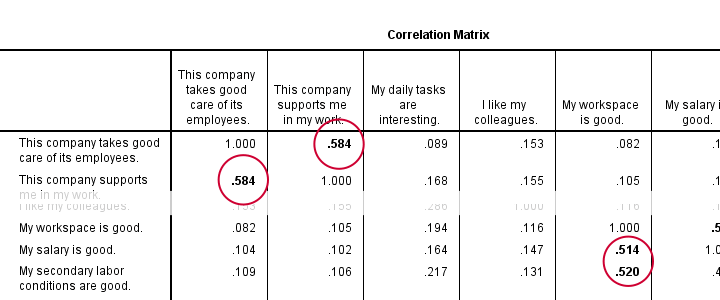
Notes
For processing all tables in the active output window, just use
OUTPUT MODIFY
/SELECT TABLES...
Optionally, specify some conditions by adding an /IF subcommand as in
OUTPUT MODIFY
/SELECT TABLES
/IF COMMANDS = ['FACTOR ANALYSIS']
Only tables that satisfy all conditions are processed. Confusingly, COMMANDS does not refer to the commands that created the output -FACTOR in this example.
Instead, COMMANDS refers to the OMS command identifiers which you can copy-paste from the output outline. The same goes for SUBTYPES and LABELS as shown below.
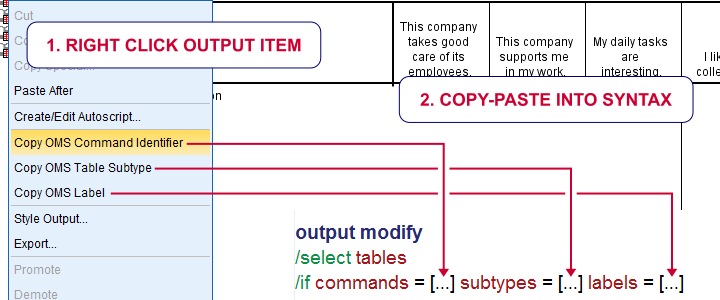
Now, the BODY of our table contains just correlations. If we set some condition, we refer to those as x as in
x > 0.5
So how to style absolute correlations between 0.50 and 1 (exclusive)? The obvious way seems
abs(x) > 0.5 & abs(x) < 1
but it somehow does not work. Instead,
0.5 < abs(x) < 1
does the job. However, it's a rather unusual way to formulate such a condition in SPSS.
Last but not least, OUTPUT MODIFY seems unable to undo the boldfacing exercise. Insofar as I understood, the syntax below should work but it doesn't.
output modify
/select tables
/if commands = ['factor analysis'] subtypes = ['Correlation Matrix']
/tablecells select = [body] selectcondition = ["0.5 < abs(x) < 1"] style = regular.
2. Set Decimal Places Output Tables - Example I
descriptives salary.
*Set format for all cells in last table -whatever that was- to dollar1 (zero decimal places).
output modify
/select tables
/if instances = [last] /*SELECT LAST PIVOT TABLE IN OUTPUT*/
/tablecells select = [body] format = 'dollar1'.
Result
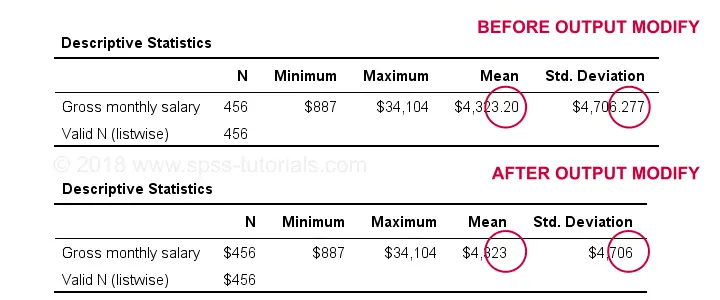
Set Decimal Places Output Tables - Example II
descriptives q1 to q4.
descriptives q5 to q9.
*Set 2 decimal places for columns 4 and 5 for all descriptives tables in output.
output modify
/select tables
/if commands = ['descriptives'] /*SELECT ALL TABLES IN OUTPUT CREATED BY DESCRIPTIVES COMMAND*/
/tablecells select = [position(4) position(5)] selectdimension = columns format = 'f3.2'.
*Note: "[position(4) position(5)] selectdimension = columns" selects columns 4 and 5.
3. Transpose One or Many Output Tables
*Run 2 basic means tables.
means q1 to q4.
means q5 to q9.
*Transpose only last means table but not case processing summary.
output modify
/select tables
/if commands = ['means(last)'] subtypes = ['report'] /* SELECT ONLY "REPORT" (DESCRIPTIVES) TABLE CREATED BY LAST MEANS COMMAND */
/table transpose = yes.
Result
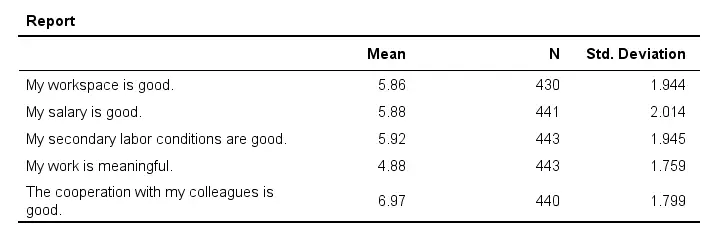
Notes
This example shows how to create much nicer descriptive statistics tables than using DESCRIPTIVES. Using MEANS instead results in a better table format and allows reporting the median as well as skewness and kurtosis without their standard errors. For more on this, see SPSS DESCRIPTIVES - Problems and Fixes.
4. Delete Selection of Output Items
frequencies gender.
descriptives salary.
crosstabs educ by marit.
means salary by gender.
correlations salary with whours.
*Delete all unwanted tables: "statistics" for frequencies and "case processing summary" for means and descriptives.
output modify
/select tables
/if subtypes = ['case processing summary','statistics']
/deleteobject delete = yes.
Result
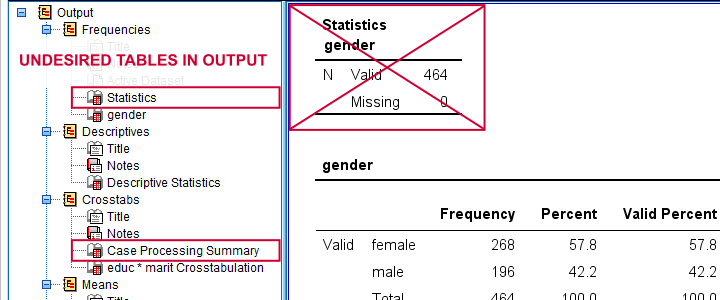
Notes
This example comes in very handy if you need to do some “quick and dirty” reporting to a client who doesn't have SPSS installed. In this case, delete all undesired output and convert the entire output document to PDF. You can do so by creating an OUTPUT EXPORT command from
 (only available in the output window).
(only available in the output window).
Alternativey, clean up your output window and convert everything in one go to an .rtf (rich text format, “WORD”) file. Since this'll include all tables and charts, you can use this as a great starting point for your final report.
5. Set Font Size for Output Tables
Note: this works properly for FREQUENCIES, DESCRIPTIVES and CORRELATIONS and only partly for MEANS and CROSSTABS.
frequencies gender.
descriptives salary.
crosstabs educ by marit.
means salary by gender.
correlations salary with whours.
*Set font sizes to 25 points.
output modify
/select tables
/tablecells select = [body,headers,title] fontsize = 25.
Result
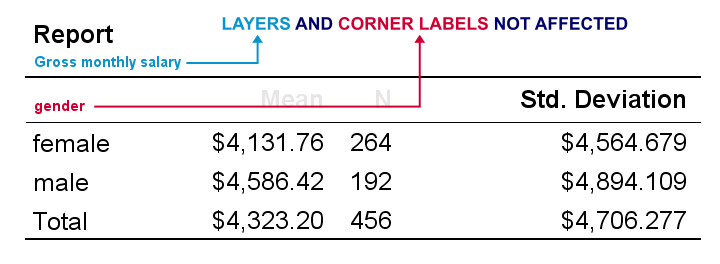
As we see, OUTPUT MODIFY seems unable to modify corner labels and layer dimensions. A workaround is creating a tablelook that sets a font size for all table elements. Next, OUTPUT MODIFY can apply this template to one, many or all output tables as shown below.
output modify
/select tables
/table tlook = "C:\Program Files\IBM\SPSS\Statistics\25\Looks\Original-15pt.stt".
*Shorthand if table template resides in default "Looks" folder (such as "C:\Program Files\IBM\SPSS\Statistics\25\Looks\").
output modify
/select tables
/table tlook = "Original-15pt".
*Don't use table template for any tables in output window.
output modify
/select tables
/table tlook = none.
Keep in mind that CD ignores the TLOOK setting, which is very annoying if your clients must replicate things on their own computers. You'll need to use absolute paths here and adjust those each time you move your project folder.
Alternatively, you can use a shorthand if you put your table templates in the default looks folder (such as C:\Program Files\IBM\SPSS\Statistics\24\Looks). However, that's typically where you don't want to develop, store and backup any project files.
6. Set Exact Size for Charts
frequencies dob
/format notable
/histogram.
*Set chart size to 720 by 300 points (resulted in 964 by 404 points).
output modify
/select charts
/objectproperties size=points(720,300).
Result
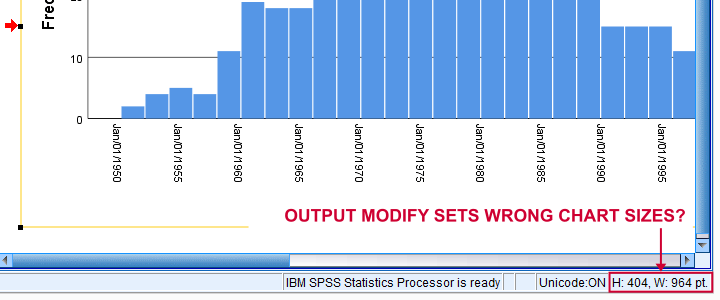
Apparently, OUTPUT MODIFY sets a different chart size than specified. For setting the correct chart sizes, try our SPSS - Set Chart Sizes Tool.
Final Notes
In this tutorial, I tried to cover the most important OUTPUT MODIFY tricks. But I still wonder:
“did I miss anything?”
If you -the reader- have any additional example(s) I should add to this tutorial, please drop me a comment below. Last but not least:
thanks for reading!
 SPSS TUTORIALS
SPSS TUTORIALS
THIS TUTORIAL HAS 17 COMMENTS:
By Jon K Peck on August 4th, 2018
On pasted syntax strategy: Most dialog boxes generate syntax that includes setting default values. While this clutters the generated syntax, by spelling out the default behavior, it reduces the need to know what the defaults are and makes it clearer how to change them. Personally, I would have opted for pasting minimal syntax, but I lost that battle many years ago.
Note also that many of the most common procedure dialogs have a Style button that lets you specify the styling at the same time as you specify the output, The Viewer styling options, while they can do many tables at once, require more interaction, although they can also generate syntax.
I also want to point out that the SPSSINC MODIFY TABLES and SPSSINC MODIFY OUTPUT extension commands are much more powerful than OUTPUT MODIFY, but they are a bit harder to use. These appear on the Utilities menu once installed via the Extensions or Utilities menu (depending on your Statistics version).
By Ruben Geert van den Berg on August 6th, 2018
Hi Jon, thanks for your feedback!
I think OUTPUT MODIFY is pretty powerful already. While working on a new tutorial, I already developed some even cooler examples than the ones presented here. Unfortunately, I stumbled upon some more bugs too. This tutorial has hardly been published and it kinda needs an update already.
I'm not sure what you mean by "more powerful", the main thing I personally miss in OUTPUT MODIFY is the ability to hide table elements. Do you have 1 or 2 examples of things that SPSSINC MODIFY TABLES and SPSSINC MODIFY OUTPUT can do but OUTPUT MODIFY can't?
By Pasquale Pepe on October 1st, 2018
What about centering all the values of a columns?
By Pasquale Pepe on October 1st, 2018
And what about selecting the dimensions of a column?
By Ruben Geert van den Berg on October 1st, 2018
Hi Pasquale!
One example in this tutorial that selects columns by position is
output modify
/select tables
/if commands = ['descriptives'] /*SELECT ALL TABLES IN OUTPUT CREATED BY DESCRIPTIVES COMMAND*/
/tablecells select = [position(4) position(5)] selectdimension = columns format = 'f3.2'.
For the exact operations on cell contents, consult the CSR. However, you can't center values in columns with OUTPUT MODFIY but you can with a table template. It's much easier too.
Hope that helps!
SPSS tutorials